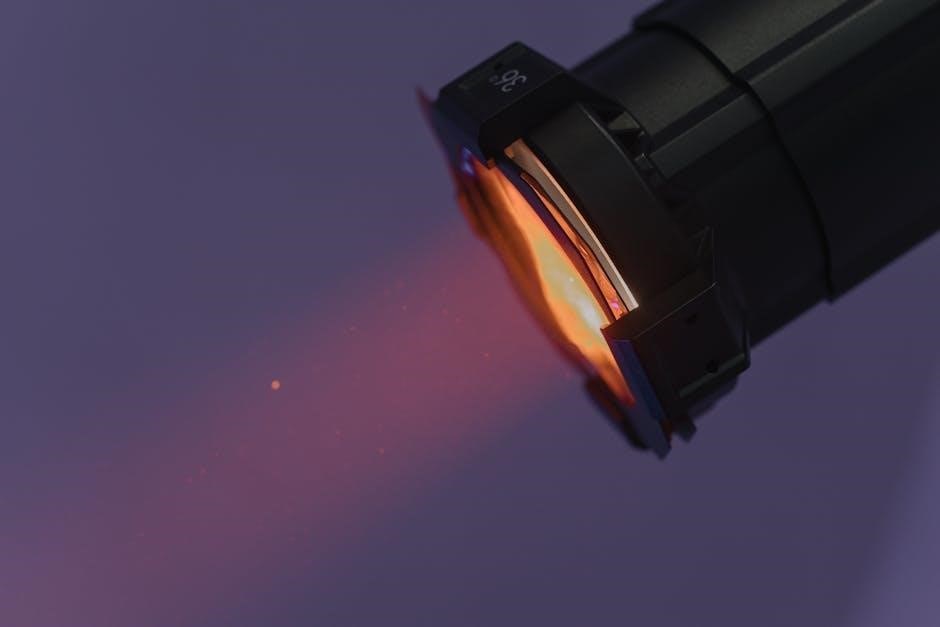Emergency lighting ensures safety during power outages and emergencies. This guide helps identify common issues like battery failures, wiring problems, and LED malfunctions. Regular maintenance and understanding test switches are crucial for reliability and compliance with safety standards.

Common Issues in Emergency Lighting Systems
Emergency lighting systems often encounter issues that compromise their reliability. Battery-related problems, such as deep discharging or loose connections, are frequent concerns. Wiring issues, including faulty connections or damaged cables, can disrupt power supply. Test switch malfunctions may prevent proper testing, while LED indicators can signal underlying faults. Circuit board failures, often caused by power surges, can render systems inoperable. Environmental factors like moisture or extreme temperatures may also degrade performance. Additionally, power outages and surges can strain the system, leading to unexpected behavior. Identifying these issues early is critical to ensuring continuous operation and safety compliance.
- Battery issues: Deep discharging, loose connections, or damaged cells.
- Wiring problems: Faulty connections, frayed cables, or corrosion.
- Test switch malfunctions: Preventing proper system testing;
- LED indicators: Flashing or dimming lights may signal faults.
- Circuit board failures: Often caused by power surges or overheating.
- Environmental factors: Moisture, dust, or extreme temperatures.
Addressing these common issues promptly ensures the system remains functional during emergencies.

Battery-Related Problems
Battery issues are common in emergency lighting systems. Deep discharging, loose connections, or damaged cells can cause malfunctions. Regular inspection and testing are essential to ensure reliability and longevity of the battery.
- Check for deep discharging or corrosion.
- Inspect connections for tightness and damage.
- Replace batteries showing signs of wear.
3.1. Inspecting the Battery for Damage
Inspecting the battery for damage is crucial for ensuring reliable operation of emergency lighting systems. Start by visually examining the battery casing for cracks, dents, or signs of impact damage, which can indicate physical stress. Check the terminals for corrosion or rust, as this can disrupt the electrical connection. Look for swelling or bloating of the battery, which may signal an internal fault. Ensure the battery is securely connected to the system, as loose connections can cause malfunctions. If the battery is old or nearing its expected lifespan, consider replacement. Use a multimeter to test the voltage and ensure it meets the manufacturer’s specifications. Proper inspection helps prevent sudden failures and ensures the emergency light functions during power outages. Regular checks can extend the battery’s lifespan and maintain overall system reliability.
3.2. Testing Battery Voltage
Testing the battery voltage is essential to ensure the emergency light system functions correctly. Begin by turning off the power supply to the unit and allowing the battery to rest for at least 30 minutes. Use a multimeter set to DC voltage mode to measure the battery’s voltage at the terminals. Refer to the manufacturer’s specifications for the expected voltage range, typically around 12V or 24V for most systems. If the reading is below the recommended level, the battery may be discharged or failing. Check for loose connections, as this can cause inaccurate readings. If the voltage is within the acceptable range but the light still malfunctions, the issue may lie elsewhere, such as in the wiring or circuit board. Regular voltage testing helps identify battery degradation early, preventing unexpected system failures during emergencies. Always follow safety precautions when working with electrical components to avoid potential risks.
3.3. Replacing the Battery
Replacing the battery in an emergency light system is a straightforward process that ensures the unit remains functional during power outages. Always disconnect the power supply before starting to avoid electrical hazards. Open the unit according to the manufacturer’s instructions, which may involve removing screws or panels. Once access is gained, carefully disconnect the old battery from the wiring harness. Inspect the connectors for corrosion or damage and clean them if necessary. Install the new battery, ensuring it is the correct type and voltage as specified in the manual. Reconnect the wiring securely to prevent loose connections. Close the unit and restore power to test the system. Properly dispose of the old battery, following environmental guidelines. Regular battery replacement extends the lifespan of the emergency light and guarantees reliable performance during emergencies. Always maintain spare batteries to minimize downtime and ensure safety compliance.
Wiring and Connection Issues
Wiring and connection problems are common in emergency lighting systems. Loose connections, corrosion, or damaged wires can disrupt power flow. Inspect all cables and terminals for wear or corrosion. Ensure all connections are secure and clean to restore proper functionality.
4.1. Checking Wiring Connections
Checking wiring connections is a critical step in troubleshooting emergency lighting systems. Begin by ensuring the unit is powered off to avoid electrical hazards. Inspect all wiring for visible damage, such as frayed cables, cuts, or signs of wear. Verify that connections between the battery, circuit board, and lighting components are secure and free from corrosion. Loose or corroded connections can disrupt power flow, causing malfunctions. Use a multimeter to test continuity and voltage levels across connections. If any wires are damaged, they may need to be repaired or replaced. Additionally, ensure that all terminals are clean and tightly fastened. Pay special attention to the connections between the battery and the charging circuit, as these are common failure points. By systematically checking each connection, you can identify and address wiring issues efficiently, restoring your emergency lighting system to proper operation.
4.2. Repairing Faulty Wiring
Repairing faulty wiring in emergency lighting systems requires careful attention to detail to ensure safety and proper functionality. Begin by disconnecting the power source to avoid electrical hazards. Identify the damaged section of the wire using a multimeter to test for breaks or short circuits. Once located, carefully strip the insulation from the ends of the damaged wire using a wire stripper. For minor damage, solder the wires together, ensuring a secure connection. For more extensive damage, replace the faulty section with a new wire of the same gauge and type. After completing the repair, wrap the connection with electrical tape or heat shrink tubing to protect it from environmental factors. Finally, reconnect the power and test the system to ensure all components function correctly. Regular maintenance and inspections can help prevent wiring issues from recurring, ensuring the emergency lighting system remains reliable during critical situations.

Test Switch Functionality
The test switch is essential for verifying the emergency light’s battery and lighting functionality. It simulates power outages to ensure the system activates correctly. Regular testing confirms reliability and readiness for real emergencies.

5.1. Understanding the Test Switch Operation
The test switch is a critical component in emergency lighting systems, designed to simulate power outages and test the backup battery’s functionality. When activated, it disconnects the unit from the main power supply, forcing the system to rely on the battery. This ensures the light illuminates correctly during emergencies.
Key steps to operate the test switch include ensuring the area is safe, turning off other lights to avoid interference, and pressing the switch to activate the test mode. The test should run for at least 30 seconds to verify consistent illumination and battery performance. After testing, release the switch to restore normal operation.
Important checks include verifying that the light activates and remains steady during the test. If the light flickers or dims, it may indicate a weak battery or faulty wiring. Regular testing ensures compliance with safety standards and guarantees reliability in real emergencies.
Troubleshooting tips include checking for a faulty test switch, ensuring proper wiring connections, and verifying battery health. A malfunctioning test switch can lead to false test results, so it’s crucial to inspect and replace it if necessary.
LED Indicators and Their Meanings
LED indicators use colors to signal system status. Green indicates normal operation, red shows issues like battery faults, and yellow signals maintenance needs, ensuring safety and compliance.
6.1. Interpreting LED Status Lights
LED status lights are essential for diagnosing issues in emergency lighting systems. They use color-coded signals to indicate system status and potential problems. A green LED typically signifies normal operation, while a red LED may indicate a battery fault, wiring issue, or power failure. Yellow LEDs often signal maintenance needs, such as a low battery or an overcharge condition. Some systems use flashing LEDs to denote specific errors, such as a rapid flash for a critical failure or a slow flash for a warning. Understanding these indicators is crucial for quick troubleshooting and ensures the system remains functional during emergencies. Always consult the manufacturer’s manual for model-specific interpretations, as LED behaviors can vary. Regularly monitoring these lights helps prevent unexpected malfunctions and ensures compliance with safety standards.

Circuit Board and Electronic Component Issues
Circuit boards and electronic components are critical for emergency light functionality. Issues like physical damage, overheating, or faulty soldering can cause malfunctions. Inspect for signs of wear or burn marks. Professional repair is often necessary for complex electronic failures.
7.1. Identifying Circuit Board Failures
Identifying circuit board failures in emergency lighting systems requires a thorough inspection. Start by visually examining the board for signs of physical damage, such as cracks, burn marks, or discoloration, which can indicate overheating or electrical surges. Check solder joints for looseness or corrosion, as these can disrupt connectivity. Use a multimeter to test voltage levels across key components like capacitors, resistors, and ICs to ensure they are functioning within specified ranges. If the board is not powering up, verify the input power source and ensure all connectors are securely attached. Firmware or software issues may also cause malfunctions, requiring updates or reprogramming. If any components are damaged or faulty, they may need to be replaced. Always refer to the manufacturer’s manual for specific troubleshooting steps, and if unsure, consult a professional to avoid further damage. Regular maintenance can help prevent such issues and ensure reliable operation during emergencies.

External Factors Affecting Emergency Lights
External factors like power outages, extreme temperatures, humidity, and dust can impact emergency light performance. Physical damage from accidents or pests may also disrupt functionality. Regular inspections help mitigate these environmental and situational challenges.
8.1. Power Outages and Surges
Power outages and electrical surges are common external factors that can significantly impact emergency lighting systems. During a power outage, emergency lights are designed to activate automatically, relying on their battery backup. However, if the battery is not functioning properly, the lights may fail to illuminate, compromising safety. Electrical surges, on the other hand, can damage the internal components of the emergency lighting system, such as the circuit board or LED drivers, leading to malfunctions or complete system failure.
It is crucial to ensure that emergency lights are equipped with surge protection to mitigate potential damage. After a power outage, it is recommended to test the system to confirm that all components are functioning correctly. Additionally, regular inspections of the battery and wiring can help identify issues caused by power fluctuations. Addressing these issues promptly ensures the reliability of emergency lighting during critical situations.
8.2. Environmental Factors Impact
Environmental factors play a significant role in the functionality and reliability of emergency lighting systems. Extreme temperatures, humidity, dust, and vibrations can all impact the performance of emergency lights. High heat can degrade batteries and electronic components, while cold temperatures may reduce battery capacity and slower charging rates. Moisture or high humidity can lead to corrosion in wiring and connections, potentially causing malfunctions. Dust accumulation on light fixtures or internal components can reduce light output and cause overheating, while vibrations from machinery or foot traffic may loosen connections over time.
To mitigate these issues, it is essential to install emergency lights in environments with stable temperatures and minimal humidity. Regular cleaning of fixtures and components can prevent dust buildup, and secure mounting can reduce the effects of vibrations. Additionally, using weather-resistant and vibration-dampening equipment can enhance system reliability in harsh environments. Addressing environmental factors ensures optimal performance and extends the lifespan of emergency lighting systems.

Advanced Troubleshooting Techniques
Advanced troubleshooting involves using specialized tools like multimeters and oscillosscopes for detailed circuit analysis. Testing power supplies, diagnosing component-level faults, and analyzing electronic signals ensure accurate identification of complex issues, improving system reliability and performance.
9.1. Using Multimeters for Detailed Testing
A multimeter is an essential tool for advanced troubleshooting of emergency lighting systems. It allows technicians to measure voltage, current, and resistance with precision. When diagnosing issues, start by setting the multimeter to DC voltage mode to check the battery’s voltage levels. Ensure the probes are correctly connected to the battery terminals, with the positive lead on the positive terminal and the negative lead on the ground. A healthy battery should read within the manufacturer’s specified voltage range, typically around 12V or 24V. If the reading is significantly lower, the battery may be faulty or deeply discharged.
Next, use the current mode to measure the flow of electricity through the circuit. This helps identify short circuits or open circuits, which can cause the system to malfunction. For resistance testing, set the multimeter to ohms mode to check wiring and connections for breaks or excessive resistance. Always refer to the user manual for specific instructions on using the multimeter safely and effectively. By following these steps, technicians can pinpoint electrical issues accurately and ensure the emergency lighting system operates reliably. Regular use of multimeters in maintenance routines can prevent unexpected failures and extend the lifespan of the system.

Importance of Regular Maintenance

Regular maintenance ensures emergency lights function reliably during power outages. It helps identify and address issues early, preventing system failures. Routine checks include testing batteries, inspecting wiring, and verifying LED functionality to ensure compliance with safety standards and extend lifespan.
10.1. Scheduling Routine Maintenance Checks
Regular maintenance is vital for ensuring emergency lighting systems function optimally. A well-structured schedule helps identify potential issues before they escalate. Start with monthly visual inspections to check for signs of damage, loose connections, or LED malfunctions. Additionally, perform functional tests every 6 months, simulating power outages to verify that lights activate correctly. Annual inspections should include detailed checks of batteries, wiring, and control panels, ensuring compliance with safety standards. Keep a maintenance log to track inspections, repairs, and replacements. This documentation is essential for audits and compliance verification. Automate reminders for maintenance tasks to avoid oversight. Regular servicing not only extends the lifespan of emergency lighting systems but also ensures reliability during critical situations. By staying proactive, you can prevent unexpected failures and maintain a safe environment.
